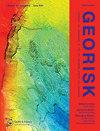Risk evaluation for earth-fill dams due to heavy rains by response surface method
IF 4.8
3区 工程技术
Q1 ENGINEERING, GEOLOGICAL
Georisk-Assessment and Management of Risk for Engineered Systems and Geohazards
Pub Date : 2023-01-12
DOI:10.1080/17499518.2023.2164901
引用次数: 1
Abstract
ABSTRACT This paper discusses a risk evaluation for earth-fill dams due to heavy rains. The detailed method employs a flood analysis and land use data to calculate the costs of the inundation damage in the downstream areas of earth-fill dams. The procedure to calculate the damage costs requires a lot of labour. Since a huge number of earth-fill dams exist in Japan, a straightforward method is needed. The response surface method, one of the surrogate models, is proposed in this study to reduce the calculation effort. The optimum response surface is firstly evaluated by cross validation, and then the accuracy is verified by comparing the damage costs obtained by the response surface method with those obtained by the detailed method for the earth-fill dam sites. To calculate the risks, it is necessary to determine the probability of overflow failure due to heavy rains. The risk of breaching is calculated from the product of the probability of overflow failure and the estimated damage costs. The accuracy of the response surface method is assessed by comparing the risk rankings of the dams, which is the priority in dam renovations, between the detailed and the response surface methods.基于响应面法的土石坝暴雨风险评价
摘要本文讨论了强降雨对土石坝的风险评估。详细方法采用洪水分析和土地利用数据来计算土坝下游地区的淹没损失成本。计算损坏成本的程序需要大量的劳动力。由于日本存在大量的填土大坝,因此需要一种简单的方法。为了减少计算工作量,本研究提出了代理模型之一的响应面方法。首先通过交叉验证对最优响应面进行评估,然后通过将响应面法获得的破坏成本与详细方法获得的填土坝址的破坏成本进行比较来验证其准确性。为了计算风险,有必要确定暴雨导致溢流失效的概率。违约风险是根据溢流故障概率和估计的损坏成本的乘积计算得出的。响应面方法的准确性是通过比较详细方法和响应面方法之间的大坝风险等级来评估的,大坝风险等级是大坝翻修的优先事项。
本文章由计算机程序翻译,如有差异,请以英文原文为准。
求助全文
约1分钟内获得全文
求助全文
来源期刊
CiteScore
8.70
自引率
10.40%
发文量
31
期刊介绍:
Georisk covers many diversified but interlinked areas of active research and practice, such as geohazards (earthquakes, landslides, avalanches, rockfalls, tsunamis, etc.), safety of engineered systems (dams, buildings, offshore structures, lifelines, etc.), environmental risk, seismic risk, reliability-based design and code calibration, geostatistics, decision analyses, structural reliability, maintenance and life cycle performance, risk and vulnerability, hazard mapping, loss assessment (economic, social, environmental, etc.), GIS databases, remote sensing, and many other related disciplines. The underlying theme is that uncertainties associated with geomaterials (soils, rocks), geologic processes, and possible subsequent treatments, are usually large and complex and these uncertainties play an indispensable role in the risk assessment and management of engineered and natural systems. Significant theoretical and practical challenges remain on quantifying these uncertainties and developing defensible risk management methodologies that are acceptable to decision makers and stakeholders. Many opportunities to leverage on the rapid advancement in Bayesian analysis, machine learning, artificial intelligence, and other data-driven methods also exist, which can greatly enhance our decision-making abilities. The basic goal of this international peer-reviewed journal is to provide a multi-disciplinary scientific forum for cross fertilization of ideas between interested parties working on various aspects of georisk to advance the state-of-the-art and the state-of-the-practice.

 求助内容:
求助内容: 应助结果提醒方式:
应助结果提醒方式:


